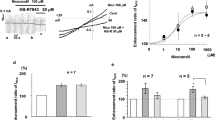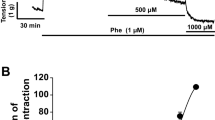Summary
Angiotensin-converting enzyme (ACE) inhibitors are widely used in the management of hypertension, heart failure, and nephropathy. It has been suggested that ACE inhibitors containing the sulfhydryl group (SH) have an additional effect on KATP channels. To prove this hypothesis, we studied the effects of the SH-containing ACE inhibitors, captopril and zofenopril, on KATP channel opening of bovine coronary arteries and guinea pig thoracic aortas. Bovine coronary arteries were precontracted with the thromboxane A2 analogue, U46619, and guinea pig thoracic aortas were precontracted with phenylephrine and then relaxed with either captopril or zofenopril (n=8). Inhibition of KATP channel opening with glibenclamide moderately attenuated the zofenopril-induced relaxation of guinea pig thoracic aorta. However, in the bovine coronary arteries, the relaxing effect of both captopril and zofenopril remained uneffected by glibenclamide. In experiments with enalapril (a non SH-containing ACE inhibitor:n=6) on guinea pig thoracic aortas, no effect on KATP channels could be seen. From our experiments, we conclude that the postulated opening of KATP channels by SH-group-containing ACE inhibitors contributes little to the vasodilation of guinea pig thoracic aortas caused by ACE inhibitors, and that SH groups have no influence upon KATP channels of bovine coronary arteries.
Similar content being viewed by others
References
Capponi AM, Aquilera G, Fakunding AL, Catt KJ (1981) Angiotensin II: Receptors and mechanisms of action. In: Soffer R (ed) Biochemical regulation of blood pressure. Wiley, New York, pp 205–262
Epstein AN (1978) The neuroendocrinology of thirst and salt appetite. In: Ganong WF, Martini L (eds) Frontiers of endocrinology, vol 5. Raven, New York, pp 101–110
Peach MJ, Bumpus FM, Khairallah PA (1971) Release of adrenal catecholamines by angiotensin I. J Pharmacol Exp Ther 171:366–369
Rayyes SS, Horton R (1971) Effect of angiotensin II on adrenal and pituitarity function in man. J Endocr Biol 82:539–543.
Reid IA, Morris BJ, Ganong WF (1978) The renin angiotensin system. Annu Rev Physiol 40:377–410
Feletou M, Germain M, Teisseire B (1992) Converting-enzyme inhibitors potentiate bradykinin-induced relaxation in vitro. Am J Physiol 262 (Heart Circ Physiol 31): H839-H845
Sargent CA, Sleph PG, Dzwonczyk S, Smith MA, Normandin D, Antonaccio MJ, Grover G (1993) Cardioprotection in ischaemic rat hearts with the SH-containing angiotensin-converting enzyme inhibitor zofenopril. Possible involvement of the ATP-sensitive potassium channel. J Pharmacol Exp Ther 265:609–618
Standen N, Quayle JM, Noel WD (1989) Hyperpolarizing vasodilators activate ATP-sensitive K channels in arterial smooth muscle. Science 245:177–180
Nelson MT, Patlak JB, Worley JF (1990) Calcium channels, potassium channels and voltage dependence of arterial smooth muscle tone. Am J Physiol 259:C3-C18
Toma CP, Serban DN, Costache V, Branisteanu DD (1995) Characteristics and possible mechanisms of low Na+ induced contractions in rat aorta. Naunyn Schmiedebergs Arch Pharmacol 352 (1):88–93
Fleckenstein A (1983) Calcium antagonism in heart and smooth muscle. Experimental facts and therapeutic prospects. A monograph. John Wiley and Sons, New York
Ashcroft FM (1988) Adenosin 5′-triphosphate-sensitive potassium channels. Annu Rev Neurosci 11:97–118
Lederer WJ, Nichols CG (1989) The mechanism of early contractile failure of isolated rat ventricular myocytes subjected to complete metabolic inhibition. J Physiol (Lond) 413:329–349
Davies NW (1990) Modulation of ATP-sensitive K-channels in skeletal muscle by intracellular protons. Nature 343:375–377
Dart C, Standen N (1993) Adenosine activated potassium current in smooth muscle cells isolated from the pig coronary artery. J Physiol (Lond) 471:767–786
Gasser R, Vaughan-Jones RD (1990) Mechanism of potassium efflux and action potential shortening during ischaemia in isolated mammalian cardiac muscle. J Physiol (Lond) 431, 713–741.
Gasser R, Klein W (1994) KATP-channels, action potential shortening and contractile failure in early myocardial ischaemia. Cardiovasc Drugs Ther 8:813–822
Richer C, Pratz J, Mulder P, Mondot S, Giudicelli JF, Cavero I (1990) Cardiovascular and biological effects of K-channel openers, a clas of drugs with vasorelaxant and cardioprotective properties. Life Sci 47:1693–1705.
Gasser R, Furian C, Grisold M, Dusleag J, Klein W (1992) Myocardial hibernation. Lancet 240:796–797
Kukovetz WR, Holzmann S, Pöch G (1992) Molecular mechanism of action of nicorandil. J Cardiovasc Pharmacol 20 [Suppl]:s1-s7
Author information
Authors and Affiliations
Rights and permissions
About this article
Cite this article
Köppel, H., Holzmann, S., Klein, W. et al. KATP channel opening does not contribute significantly to the vasodilatory effect of SH-group-containing ACE inhibitors. Heart Vessels 11, 192–196 (1996). https://doi.org/10.1007/BF02559991
Received:
Revised:
Accepted:
Issue Date:
DOI: https://doi.org/10.1007/BF02559991




